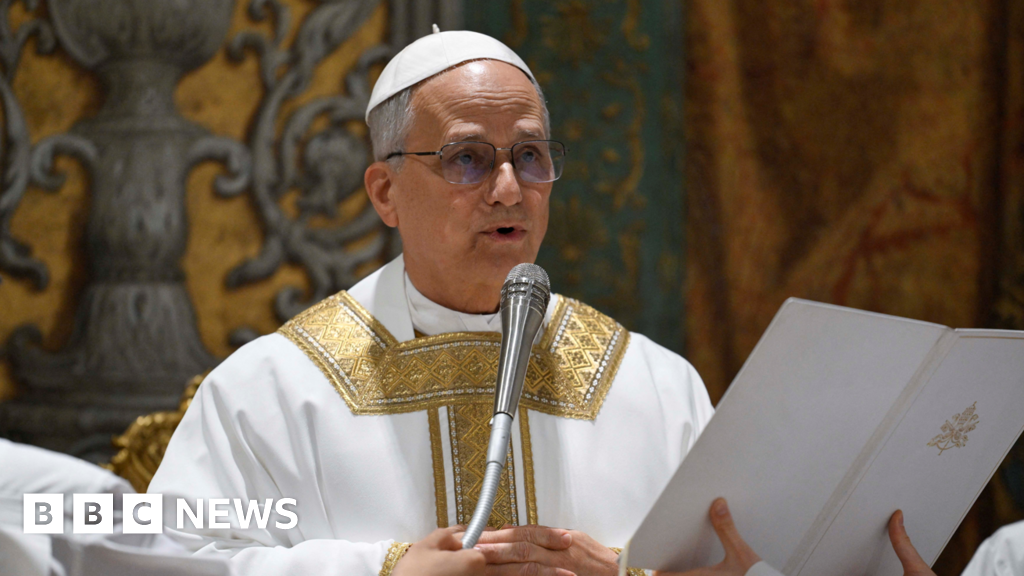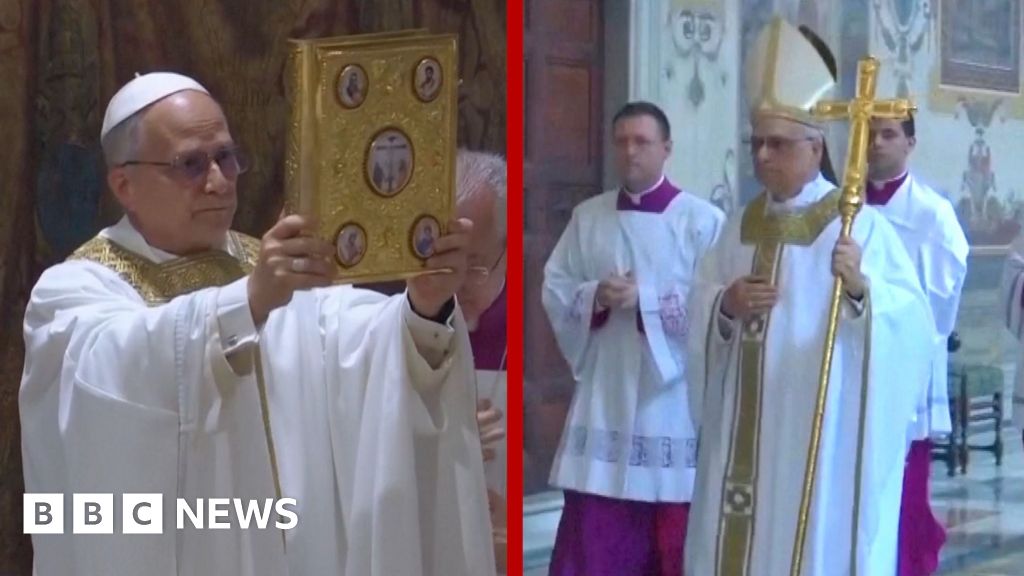ARTICLE AD BOX
By Sean Coughlan
BBC News royal correspondent
Image source, Getty Images
Image caption,The future Queen, her mother and a nurse, leaving 17, Bruton Street for her christening
Where exactly was the site of the house where the Queen was born? Have visitors been looking in the wrong place? And are the claims that the house was damaged in the Blitz correct?
The Queen was born on 21 April 1926 at 17, Bruton Street in Mayfair, London. Not a palace or a big estate or even a hospital, but a townhouse on a busy London street.
Her parents had moved into the house, belonging to her Scottish grandparents, the Earl and Countess of Strathmore, only a few weeks before her birth.
"It's a reminder of how the royal family was not as flush in those days. Money was an issue," says royal historian Robert Lacey.
Bear in mind, the Queen was not born to be Queen - at this point, as the daughter of the King's younger son, she was not expected to take the throne.
Your device may not support this visualisation
Was the house 'Blitzed'?
The Queen's first home no longer stands - and there are persistent claims online it was a casualty of air raids during the Second World War.
"The house was damaged in the Blitz and later demolished," says Wikipedia, as one example of many.
But armfuls of documents in the British Library and other archives show that the 18th century house was gone before the war had even started.
It was property developers - much more relentless than air raids - that finished off the Queen's first home.
A modern entrance on Bruton Street close to the site of the original 17, Bruton Street
In 1937, a man in a top hat and frock coat had formally begun the demolition of 17, Bruton Street and many of its neighbouring buildings stretching around the corner into Berkeley Square.
There had been plans to build a hotel for the Canadian Pacific Railway, but the site was eventually cleared for a big office and retail complex.
These were unsentimental times about architectural heritage. Without a glimmer of regret, demolition gangs flattened what was described by one report at the time as "20 of the most historic houses in London".
A poignant drawing by the war artist Sir Muirhead Bone recorded workmen pulling down the facades of the elegant old buildings.
If there was any further doubt, a surveyor's note from May 1939, in the London Metropolitan Archive, closed the file on the original 17, Bruton Street with a confirmation that the old house had been demolished and "its site forms part of that upon which Berkeley Square House has been built".
Image source, Topical Press Agency
Image caption,Elizabeth Bowes-Lyon, the Queen's mother, leaving Bruton Street on her wedding day in 1923
Astrea, the firm currently running the Berkeley Square House site, says a new building on the site was occupied by the air ministry, in the run-up to the Second World War.
Is it now a Chinese restaurant?
But there's another frequently repeated claim about the Queen's birthplace - that the site is now a Chinese restaurant.
This, again, is not the full story.
The Hakkasan restaurant has the same 17, Bruton Street address. But so does a stretch of boarded-up office in the same block. There's also a glass-fronted, corporate entrance and reception area next door. All of this extended business block is built over what, in the 1920s, would have been a row of individual, private houses.
Image source, Getty Images
Image caption,A block stands over what had been a row of individual private houses in the 1920s
It might not be such a romantic story, but it's the rather anonymous corporate entrance that seems closest to the site of the original 17, Bruton Street: a side entrance into some offices in Berkeley Square House.
Car showroom
In the London Metropolitan Archive in Clerkenwell, there are bundles of old files and architects' drawings, with art deco lettering, showing the layout of the original house.
They show the lost house would have been around this entrance area, with the frontage stretching down towards what is now a car showroom selling Bugattis and Bentleys.
Image source, Universal History Archive
Image caption,The original 17, Bruton Street, where the Queen was born in 1926
This is confirmed by Westminster City Council whose planners say this can be plotted against the boundary lines of original properties on the other side of the street.
One end of the restaurant would have overlapped with the original house, and Hakkasan general manager Sharon Wightman says the royal connection is a "brilliantly interesting talking point, which goes down well with our guests".
But much of the Queen's old home is now replaced by the corporate glass of the entrance next door.
There are two plaques on an adjacent wall marking the birthplace, including one from Westminster Council. These have been moved as the buildings have been altered and are at one end of the original site.
A boarded-up unit in Bruton Street is also number 17
There's no official blue plaque because a spokeswoman for English Heritage says they have to be on original buildings - and, also, they don't put up plaques for living people.
Toby Cuthbertson, from Westminster's planning department, says this would have been a high-class, "first-rate" London property, five bays wide - but the very wealthy would have been another step up, in the type of houses that had names, rather than numbers.
Image source, Topical Press Agency
Image caption,Delivery men at 17, Bruton Street, which was owned by the parents of the Queen's mother
When the Queen was born here in 1926, her royal grandparents came to see her on that first day. Queen Mary recorded in her diary that her grand-daughter was "a little darling, with a lovely complexion and pretty fair hair".
It's also where the Home Secretary William Joynson-Hicks hurried, as it was then still protocol that the home secretary was present for such a royal birth. He was considered such an authoritarian, he was nicknamed "Mussolini minor".
Image source, Topical Press Agency
Image caption,Well-wishers lined the street when Elizabeth Bowes-Lyon departed 17, Bruton Street for her wedding
This was the house where the Queen's mother, Elizabeth Bowes-Lyon, had set out in April 1923 for her wedding to her shy suitor, the then Duke of York. They returned here for the birth of their first child almost exactly three years later.
The house was also in walking distance of the Harley Street practice of speech therapist Lionel Logue who, from 1926, helped the future King overcome his stammer.
No tourist trail
This would have been a Mayfair of upper-class parties and fashionable gatherings.
But it was also a politically volatile and divided time. The general strike was called only a few weeks after the Queen's birth and her grandfather, George V, had cautioned: "Try living on their wages before you judge them."
The Queen and her parents moved later that year to a bigger house in Piccadilly.
Image source, London Metropolitan Archive
Image caption,There were plans to convert the original 17, Bruton Street into offices
There were subsequent plans to convert the house in Bruton Street into offices, with architects' drawings showing how the rooms, including where the Queen was born, would have been panelled, partitioned and redesigned for office workers.
"The room on the first floor, in which the little princess was born, is one of the least ornate of all the rooms, but also one of the sunniest," read a newspaper account at the time.
But the house was later demolished - and remains a curiously low-key site for such an historic place. There can't have been many private houses in London which were the family home for a future King and two Queens - yet it's barely on the tourist trail.
"I think it reflects the general modesty of the Queen," says historian Robert Lacey. "She doesn't blow her own trumpet."
Current value
The site is still part of a royal estate, but, these days, it belongs to the estate of the royal family of Abu Dhabi - part of a portfolio of property in this part of London said to be worth £5bn.
The original 17, Bruton Street was managed in the early 1930s by Howard Frank, co-founder of the Knight Frank estate agency.
In the British Library, maps and records show the house from the 18th Century onwards
Simon Burgoyne, now working for Knight Frank on property in modern Mayfair, says this fashionable area was, at the time, where landed families - with estates in the country - had their London townhouses.
"But after the war, no one could afford to keep these big, old, rambling buildings, so a lot of them were turned into offices," he says.
This has now come full circle, says Mr Burgoyne, with offices being turned back into luxury residential property. If the house had survived, it would have been worth well over £25m, he says, and possibly as much as £100m.
Secret lover
But the house was flattened in 1937 - and, in another unexpected turn, by then the young Elizabeth and her parents had moved into Buckingham Palace.
The abdication crisis of 1936 had seen her father take the throne as George VI, following his brother Edward VIII's planned marriage to an American divorcee, Wallis Simpson.
Mrs Simpson been followed by Special Branch officers during this political maelstrom and they had noted claims that she had had an affair with a car salesman called Guy Marcus Trundle.
In a final twist, the address where they found this "charming adventurer" was 18, Bruton Street, now, appropriately, part of the Bentley dealership.

 3 years ago
106
3 years ago
106








 English (US) ·
English (US) ·